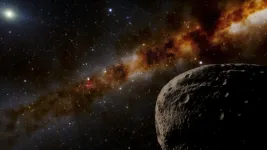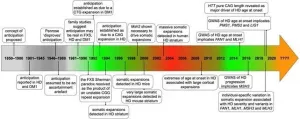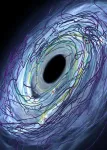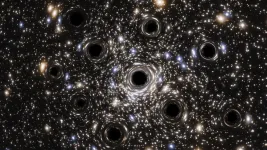(Press-News.org) With the help of the international Gemini Observatory, a Program of NSF's NOIRLab, and other ground-based telescopes, astronomers have confirmed that a faint object discovered in 2018 and nicknamed "Farfarout" is indeed the most distant object yet found in our Solar System. The object has just received its designation from the International Astronomical Union.
Farfarout was first spotted in January 2018 by the Subaru Telescope, located on Maunakea in Hawai'i. Its discoverers could tell it was very far away, but they weren't sure exactly how far. They needed more observations.
"At that time we did not know the object's orbit as we only had the Subaru discovery observations over 24 hours, but it takes years of observations to get an object's orbit around the Sun," explained co-discoverer Scott Sheppard of the Carnegie Institution for Science. "All we knew was that the object appeared to be very distant at the time of discovery."
Sheppard and his colleagues, David Tholen of the University of Hawai'i and Chad Trujillo of Northern Arizona University, spent the next few years tracking the object with the Gemini North telescope (also on Maunakea in Hawai'i) and the Carnegie Institution for Science's Magellan Telescopes in Chile to determine its orbit. [1] They have now confirmed that Farfarout currently lies 132 astronomical units (au) from the Sun, which is 132 times farther from the Sun than Earth is. (For comparison, Pluto is 39 au from the Sun, on average.)
Farfarout is even more remote than the previous Solar System distance record-holder, which was discovered by the same team and nicknamed "Farout." Provisionally designated 2018 VG18, Farout is 124 au from the Sun.
However, the orbit of Farfarout is quite elongated, taking it 175 au from the Sun at its farthest point and around 27 au at its closest, which is inside the orbit of Neptune. Because its orbit crosses Neptune's, Farfarout could provide insights into the history of the outer Solar System.
"Farfarout was likely thrown into the outer Solar System by getting too close to Neptune in the distant past," said Trujillo. "Farfarout will likely interact with Neptune again in the future since their orbits still intersect."
Farfarout is very faint. Based on its brightness and distance from the Sun, the team estimates it to be about 400 kilometers (250 miles) across, putting it at the low end of possibly being designated a dwarf planet by the International Astronomical Union (IAU).
The IAU's Minor Planet Center in Massachusetts announced today that it has given Farfarout the provisional designation 2018 AG37. The Solar System's most distant known member will receive an official name after more observations are gathered and its orbit becomes even more refined in the coming years.
"Farfarout takes a millennium to go around the Sun once," said Tholen. "Because of this, it moves very slowly across the sky, requiring several years of observations to precisely determine its trajectory."
Farfarout's discoverers are confident that even more distant objects remain to be discovered on the outskirts of the Solar System, and that its distance record might not stand for long.
"The discovery of Farfarout shows our increasing ability to map the outer Solar System and observe farther and farther towards the fringes of our Solar System," said Sheppard. "Only with the advancements in the last few years of large digital cameras on very large telescopes has it been possible to efficiently discover very distant objects like Farfarout. Even though some of these distant objects are quite large -- the size of dwarf planets -- they are very faint because of their extreme distances from the Sun. Farfarout is just the tip of the iceberg of objects in the very distant Solar System."
INFORMATION:
Notes
[1] The Gemini North observations of Farfarout were done on 1 May and 2 May 2019 Universal Time, using Director's Discretionary Time.
More information
NSF's NOIRLab (National Optical-Infrared Astronomy Research Laboratory), the US center for ground-based optical-infrared astronomy, operates the international Gemini Observatory (a facility of NSF, NRC-Canada, ANID-Chile, MCTIC-Brazil, MINCyT-Argentina, and KASI-Republic of Korea), Kitt Peak National Observatory (KPNO), Cerro Tololo Inter-American Observatory (CTIO), the Community Science and Data Center (CSDC), and Vera C. Rubin Observatory (in cooperation with DOE's SLAC National Accelerator Laboratory). It is managed by the Association of Universities for Research in Astronomy (AURA) under a cooperative agreement with NSF and is headquartered in Tucson, Arizona. The astronomical community is honored to have the opportunity to conduct astronomical research on Iolkam Du'ag (Kitt Peak) in Arizona, on Maunakea in Hawai?i, and on Cerro Tololo and Cerro Pachón in Chile. We recognize and acknowledge the very significant cultural role and reverence that these sites have to the Tohono O'odham Nation, to the Native Hawaiian community, and to the local communities in Chile, respectively.
Links
University of Hawai'i press release
NAOJ/Subaru press release
Minor Planet Circular 2021-C187
Photos of Gemini North telescope
2018 talk mentioning Farfarout by Scott Sheppard
"Beyond Pluto: the Hunt for a Massive Planet X"
Contacts
Scott Sheppard
Earth and Planets Laboratory
Carnegie Institution for Science
Tel: +1 202-478-8854
Email: ssheppard@carnegiescience.edu
David Tholen
University of Hawai'i
Email: tholen@hawaii.edu
Chad Trujillo
Northern Arizona University
Email: chad.trujillo@nau.edu
Amanda Kocz
Press and Internal Communications Officer
NSF's NOIRLab
Cell: +1 626-524-5884
Email: amanda.kocz@noirlab.edu
A report summary released today by a team at Lehigh University led by Thomas McAndrew , a computational scientist and assistant professor in Lehigh's College of Health, shares the consensus results of experts in the modeling of infectious disease when asked to rank the top 5 most effective interventions to mitigate the spread and impact of COVID-19 in the U.S.
The report is part of an ongoing meta forecasting project aimed at translating forecasting and real world experience into actions.
McAndrew and his colleagues wanted to answer "Here is where ...
Wilmington, DE, Feb. 11, 2020 -Scientists have developed an affordable, downloadable app that scans for potential unintended mistakes when CRISPR is used to repair mutations that cause disease. The app reveals potentially risky DNA alterations that could impede efforts to safely use CRISPR to correct mutations in conditions like sickle cell disease and cystic fibrosis. The development of the new tool, called DECODR (which stands for Deconvolution of Complex DNA Repair), was reported today in The CRISPR Journal by researchers from ChristianaCare's Gene Editing Institute.
"Our research has shown that when CRISPR is used to repair a gene, it also can introduce a variety of subtle changes to DNA near the site of the repair," said Eric ...
Amsterdam, February 11, 2021 - Recent genetic data from patients with Huntington's disease (HD) show that DNA repair is an important factor that determines how early or late the disease occurs in individuals who carry the expanded CAG repeat in the HTT gene that causes HD. The processes of DNA repair further expand the CAG repeats in HTT in the brain implicated in pathogenesis and disease progression. This special issue of the Journal of Huntington's Disease (JHD) is a compendium of new reviews on topics ranging from the discovery of somatic CAG repeat expansion in HD, to our current understanding of the molecular mechanisms involved ...
In the last 25 years, scientists have discovered over 4000 planets beyond the borders of our solar system. From relatively small rock and water worlds to blisteringly hot gas giants, the planets display a remarkable variety. This variety is not unexpected. The sophisticated computer models, with which scientists study the formation of planets, also spawn very different planets. What the models have more difficulty to explain is the observed mass distribution of the planets discovered around other stars. The majority have fallen into the intermediate mass category - planets with masses of several Earth masses to around that of Neptune. Even in ...
LAWRENCE -- Nearly every fall, as football teams return to the field, tragic stories of players falling ill and even dying of heat trauma make the headlines. What many don't consider is that marching band members -- who don heavy uniforms and perform in the same sweltering temperatures -- may also be at risk.
A study led by the University of Kansas has measured core temperatures, hydration and sweat levels of marching band members and found that they are very much at risk and deserve access to athletic trainers for their safety -- just as players do.
The study used high tech methods to gauge band members' body core ...
A study led by researchers at Baylor College of Medicine reveals a novel role of the steroid receptor coactivator 3 (SRC-3/NCOA3), a protein crucial for steroid hormone function and a prognostic marker for aggressive human breast and other cancers.
The team discovered that SRC-3 also regulates human immune T regulatory cells (Tregs), which contribute to the regulation of the body's immunological activity by suppressing the function of other immune cells, including those involved in fighting cancer. The study, which appears in the journal Scientific Reports, shows that Tregs whose SRC-3 function was eliminated failed to suppress the activity of other immune cells in the lab. The authors anticipate that their findings ...
The golden-mantled ground squirrel (Callospermophilus lateralis) is a popular sight among tourists in the Rocky Mountains--the small rodent is a photogenic creature with a striped back and pudgy cheeks that store seeds and other food.
But there's a reality that Instagram photos don't capture, said Christy McCain, an ecologist at the University of Colorado Boulder. In a new study spanning nearly 13 years, she and her colleagues discovered that the ground squirrel has joined many other small mammals in Colorado's Rocky Mountains that are making an ominous trek: They're climbing uphill to avoid warming temperatures in the state brought on by climate change.
"It's frightening," ...
Globular clusters are extremely dense stellar systems, in which stars are packed closely together. They are also typically very old -- the globular cluster that is the focus of this study, NGC 6397, is almost as old as the Universe itself. It resides 7800 light-years away, making it one of the closest globular clusters to Earth. Because of its very dense nucleus, it is known as a core-collapsed cluster.
When Eduardo Vitral and Gary A. Mamon of the Institut d'Astrophysique de Paris set out to study the core of NGC 6397, they expected to find evidence for an "intermediate-mass" black hole (IMBH). These are smaller than the supermassive black holes that lie at the cores of large galaxies, but larger than stellar-mass black holes ...
Rheumatic heart disease (RHD) develops as a long term complication of childhood streptococcal angina. Latent RHD can be detected with echocardiography years before it becomes symptomatic. RHD is curable when treated early with medication.
RHD is responsible for over 300 000 deaths worldwide each year, accounting for just over two-thirds of all deaths from valvular heart diseases. RHD is disproportionally prevalent across sub-Saharan Africa, South Asia and the Pacific Islands and largely a phenomenon of marginalized communities in developing and emerging countries whereas ...
Millions of tonnes of plastic waste find their way into the ocean every year. A team of researchers from the Institute for Advanced Sustainability Studies (IASS) in Potsdam has investigated the role of regional ocean governance in the fight against marine plastic pollution, highlighting why regional marine governance should be further strengthened as negotiations for a new global agreement continue.
In recent years, images of whales and sea turtles starving to death after ingesting plastic waste or becoming entangled in so-called ghost nets have led to a growing ...





